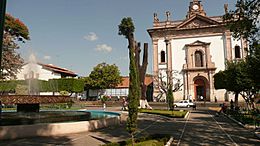Environment facts for kids
The environment is everything around us. It includes all the living and non-living things in a specific area. For example, a hot desert or a swampy forest are both types of environments. Living things are called biotic (like animals and plants), and non-living things are called abiotic (like air, water, and rocks).
Living things constantly interact with their environment. They also adapt to its conditions to survive. Think about how a cactus adapts to a dry desert or how a polar bear adapts to the cold Arctic. The environment affects how living things grow, behave, and even how they look.
The word "environment" can be used in many ways. For example, in science, it might mean the conditions in space around a galaxy. In psychology and medicine, a person's environment includes the people, places, and things they live with. This environment greatly affects a person's growth and how they develop.
Contents
Understanding Your Environment
The environment is made up of many different parts that all work together. These parts include:
All these things interact with each other. For instance, plants get minerals from the soil and use sunlight to make their food. Animals eat plants or other animals. This constant interaction creates a complex system.
Natural Environment
When we talk about the natural environment, we mean all the natural materials and living things that exist without much human interference. This includes everything from tiny microorganisms to huge forests, rocks, and the air we breathe.
Studying the natural environment means looking at how living things (biotic elements) interact with non-living things (abiotic elements).
- Biotic elements are living parts, like animals, plants, and bacteria.
- Abiotic elements are non-living parts, like air, water, sunlight, and soil.
For example, a plant (biotic) gets nutrients from the soil (abiotic) and energy from the sun (abiotic). A lion (biotic) hunts a zebra (biotic). All these connections are part of the natural environment.
Protecting Our Natural Resources
Many people care deeply about protecting the natural environment. These people are often called environmentalists. They believe it's important to keep our planet safe and healthy for everyone.
Things in the natural environment that are valuable to us are called natural resources.
- Renewable resources are those that can come back naturally after we use them. Examples include fish, insects, and forests. If we use them wisely, they can be replaced.
- Non-renewable resources are limited. Once they are used up, they are gone forever or take millions of years to form again. Examples include ores (like iron or copper) and fossil fuels (like coal, oil, and natural gas).
Some parts of the natural environment can also be dangerous, like lightning during a storm.
Historical Environment
A historical environment refers to the events and culture that people lived in during a specific time period. It's about understanding how past societies and their beliefs shaped people's actions.
For example, many years ago, in different societies, certain practices were considered normal that we would see as wrong today. People's beliefs and actions are often influenced by the environment they grow up in. This helps us understand history better by looking at the world through the eyes of people from the past.
See also
In Spanish: Medio ambiente (desambiguación) para niños



